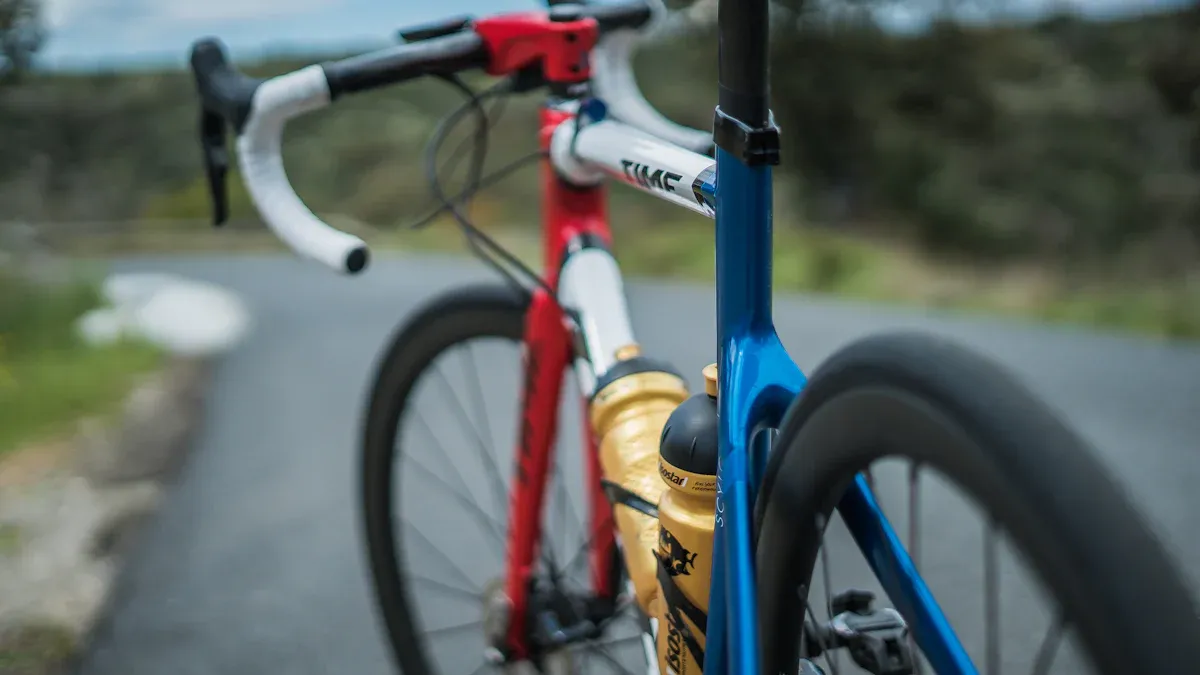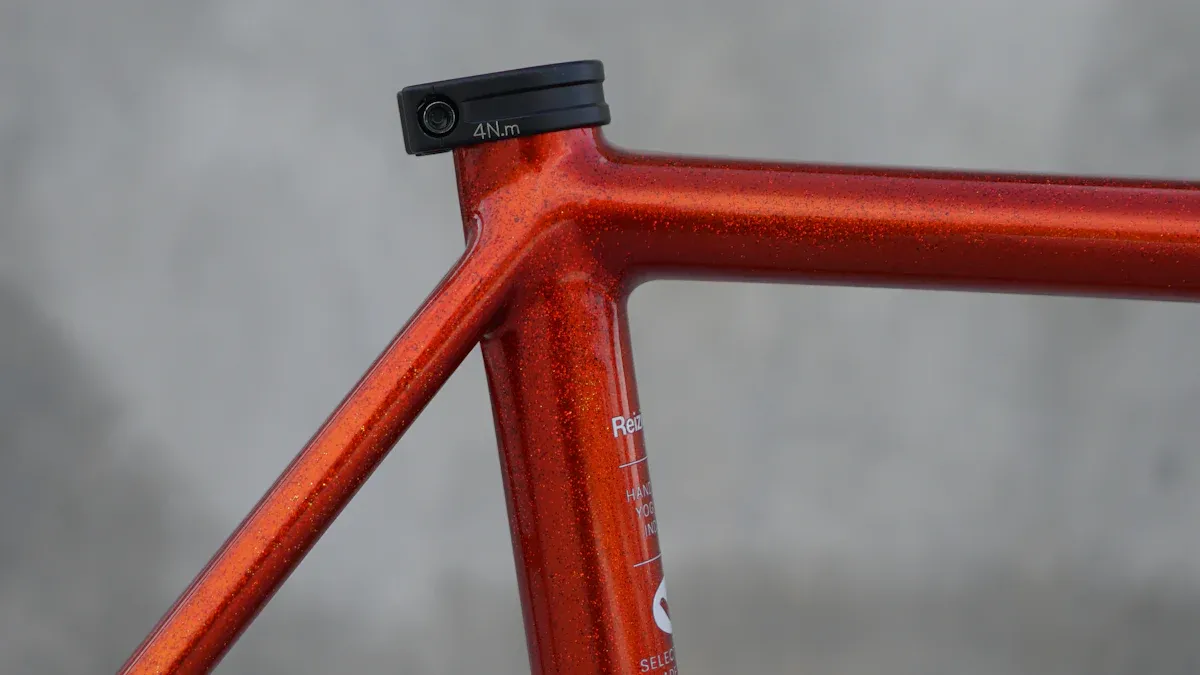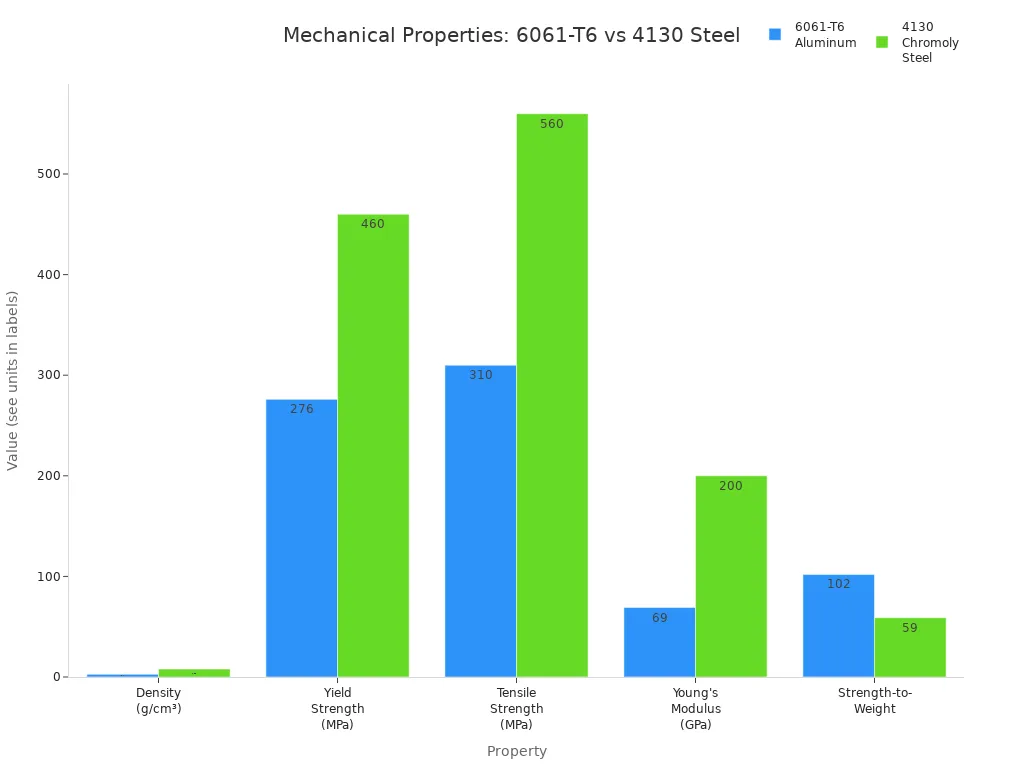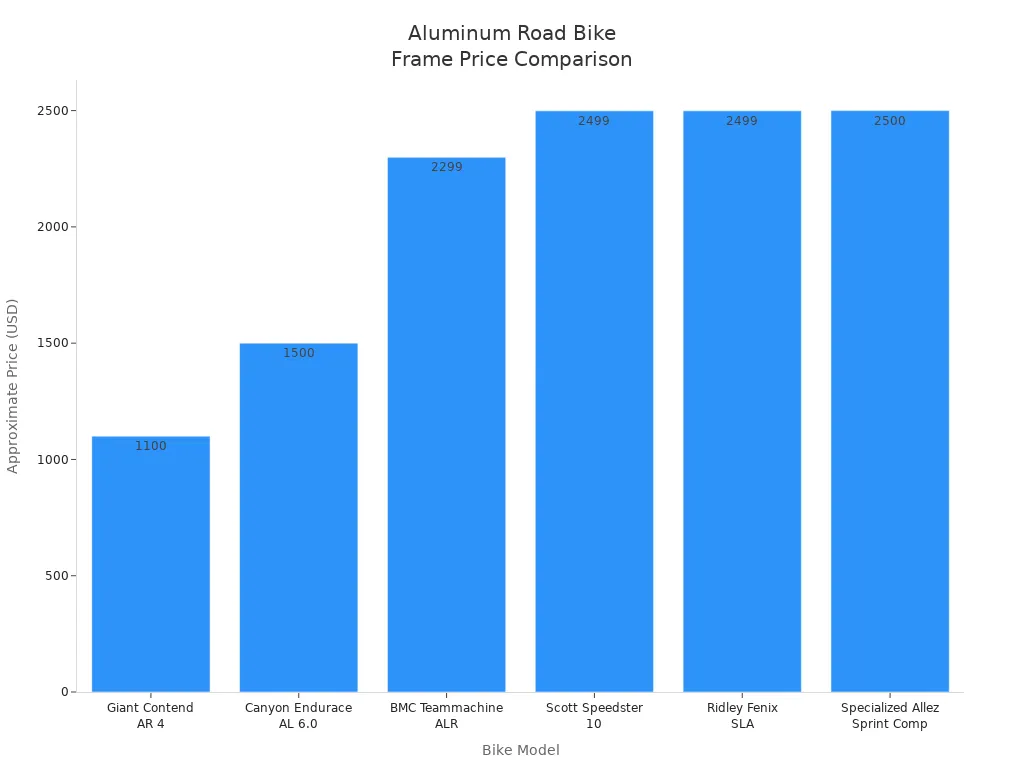
Choosing the right aluminum road bike frame helps you get a bike that fits your needs. It also makes every ride feel good. Aluminum frames are very popular. They make up over 60% of all road bikes sold in the world. You should pick frame features that match your riding goals. This gives you better comfort and performance. Before you choose a bike, think about how you want to use it. You might want to race, commute, ride long distances, or just have fun.
Aluminum frames are light and do not cost much.
The design of each aluminum road bike frame can change how your bike feels and works.
Many riders like the mix of weight, price, and ride quality that aluminum gives.
Key Takeaways
Aluminum road bike frames are light, strong, and not too expensive. This makes them a good choice for many people.
Picking the right frame size and shape helps you feel better on your bike. It also helps you control the bike and ride faster. Always try out the bike and make sure it fits you well.
New aluminum frames are shaped in special ways. This helps stop bumps from the road and makes long rides more comfortable. It is also good for riding every day.
There are different types of aluminum alloys, like 6061 and 7005. These change how strong the frame is and how it feels to ride. 6061 is easier to shape and gives a smoother ride. 7005 is stronger but feels harder when you ride.
Getting better wheels and tires can make your bike faster and more comfortable. You do not need a new frame to do this.
Why Frame Choice Matters
Ride Quality
When you choose a frame for your road bike, you shape how every ride feels. The frame acts as the backbone of your bike. It connects all the parts and decides how much comfort you get on the road. Many cyclists say that changing only the frame, while keeping other parts the same, can make a huge difference in your riding experience.
The frame affects how much vibration you feel from the road.
It controls how smooth or rough your ride becomes.
The right frame size helps you stay comfortable and avoid pain or injury.
Aluminum road bike frames send more road vibrations to your hands and body. You might feel bumps and rough patches more than with other materials. Over long rides, this can cause numbness or fatigue. However, modern aluminum frames use special shaping methods, like hydroforming, to make the ride smoother. You can also improve comfort by choosing wider tires or padded handlebars.
Note: The frame is the most important and expensive part of your bike. It affects fit, ride quality, and handling more than any other part.
Performance
Your frame choice also shapes how your road bike performs. A good frame lets you ride faster, climb hills easier, and handle sharp turns with confidence. Aluminum frames are light and stiff. This means you can transfer your pedaling power directly to the road. You get quick acceleration and responsive handling, which is great for a performance bike.
Aluminum frames are popular because they are affordable and strong.
They give you a direct road feel, which helps you react quickly.
The frame’s geometry affects how your bike handles at high speeds or in tight corners.
Compared to carbon fiber, aluminum frames cannot be shaped into complex aerodynamic forms. This limits top-end speed for racing. Carbon fiber absorbs more vibration, so it feels smoother on rough roads. Still, many riders pick aluminum for its value and solid performance on the road. You can upgrade other parts later, but the frame sets the foundation for your bike’s performance.
Tip: Cyclists often choose their frame based on riding style, goals, and budget. The right frame can save you money over time and make every road ride more enjoyable.
Riding Styles

Racing
If you want to race, you need a bike that feels fast and responsive. Aluminum frames give you a stiff and light ride. This helps you push power into the pedals and move quickly on the road. Many racers choose aluminum because:
The frame is light, so you can speed up fast.
Stiffness means you do not lose energy when you pedal.
Hydro-forming shapes the tubes for better strength and ride quality.
Aluminum costs less than carbon, so you can buy better wheels or parts for your bike.
If you crash, the frame may dent but often stays rideable.
You get a strong strength-to-weight ratio. This makes your road bike a good choice for racing, especially if you want to save money and still get great performance.
Endurance
Long rides need a bike that keeps you comfortable and strong. Modern aluminum frames use special tube shapes. These shapes make the bike stiff where needed and flexible where it matters. You can ride for hours on the road without feeling too much fatigue.
Note: Aluminum frames do not have a true fatigue limit, but they last a long time for most riders. The comfort you feel comes from the frame design, tire width, and your position on the bike.
Endurance bikes balance comfort and speed. You can trust an aluminum frame for long road rides. The frame will stay strong and reliable for many years.
Commuting
For daily commuting, you want a bike that is tough and practical. Aluminum frames handle city roads well. They stand up to potholes, curbs, and rough surfaces. Many commuter bikes use aluminum because:
The frame is strong and durable.
You can add racks, fenders, and lights to your bike.
Wider tires and relaxed geometry help smooth out the road.
Aluminum frames cost less, so you can spend more on other parts.
Modern aluminum frames use hydroforming to make the ride smoother. You get a comfortable and reliable road bike for your daily trips.
Recreation
If you ride for fun, you want a bike that is easy to handle and lasts a long time. Aluminum frames are light and resist rust. They help you enjoy road biking without spending too much money.
Frame Attribute | What It Means for You |
|---|---|
Lightweight | Easy to ride and control |
Corrosion Resistance | Frame lasts longer on the road |
Stiffness | Quick starts, but more road vibration |
Cost-effectiveness | Good value for your money |
Comfort | Some vibration, but modern frames help |
You may feel more bumps on the road, but you get a bike that is simple to care for and fun to ride. Most aluminum frames last 5-7 years with regular use, making them a smart choice for recreational riders.
Aluminum Road Bike Frame Features

Weight & Stiffness
When you look at a modern aluminum road bike frame, you notice how light it feels. Most high-end aluminium frames weigh between 3 to 4 pounds. This weight puts them close to carbon frames, which are only about a pound lighter. You get a bike that is easy to lift, carry, and ride up hills. The light weight helps you speed up quickly and makes long road rides less tiring.
Stiffness is another key feature of an aluminum frame. Stiff frames do not bend much when you push hard on the pedals. This means more of your energy goes straight into moving the bike forward. You feel a direct connection to the road, especially when you sprint or climb. Manufacturers use larger bottom brackets and special tube shapes to make the frame stiff where it matters most.
Lateral stiffness around the bottom bracket improves power transfer.
Stiff frames help you accelerate fast and handle sharp turns with confidence.
Torsional stiffness keeps the bike steady when you corner at high speeds.
Note: Stiffness gives you a fast and responsive ride, but it can also make the bike feel harsh on rough roads. You may notice more bumps and vibrations, which can lead to fatigue if you ride for a long time.
Finding the right balance between weight and stiffness is important. Too much stiffness can make the ride uncomfortable, while too little can waste your energy. Most modern aluminium road bike frames aim for a mix that works well for many riders.
Comfort & Compliance
Comfort matters on every road ride. Early aluminium frames felt very stiff and rough. Today, manufacturers use new designs to make your ride smoother. Hydroformed tubes let them shape the frame in special ways. They make some parts stiff for power and others flexible for comfort.
Hydroforming creates tubes that are thick where you need strength and thin where you want more give.
Shaped seat stays and forks help absorb road vibrations.
Tube shaping lets the frame flex up and down, making the ride less harsh.
You feel less shock from bumps and cracks in the road. This helps you stay comfortable, even on long rides. The frame’s compliance, or ability to flex, works with your tires and seat to smooth out the road. Some riders say modern aluminium frames feel almost as comfortable as carbon frames on regular roads.
Tip: Comfort depends on more than just the frame. Your tire choice, seat, and handlebar padding also play a big role in how your bike feels.
Durability
Durability is a big reason many riders choose an aluminum road bike frame. Aluminium resists rust, so your bike stays looking good even if you ride in the rain. The frame stands up well to bumps and small crashes. If you hit something hard, the frame may dent, but you can usually see the damage right away.
Aluminum frames last about 5 to 7 years with regular use. Over time, tiny cracks can form at the welds from normal flexing. These cracks grow slowly and usually do not cause sudden failure. Steel frames last longer, but they can rust. Carbon frames resist repeated stress very well, but they can break if you crash hard and the damage is not always easy to see.
Frame Material | Durability | Impact Resistance | Fatigue Life | Corrosion Resistance |
|---|---|---|---|---|
Aluminium | Good (5-7 years) | Dents, visible | Limited | Excellent |
Steel | Excellent | Bends, visible | Very Long | Poor (can rust) |
Carbon Fiber | Very Good | Hidden cracks | Very Long | Excellent |
Note: Aluminium frames give you a sturdy, corrosion-resistant bike that offers good value for your money. You get a frame that is easy to care for and strong enough for most road riding needs.
Bicycle Frames: Materials & Alloys
When you look at bicycle frames, you see different materials and alloys. These are used to make bikes strong, light, and tough. Aluminum is a popular choice for road bikes. It gives good performance and is not too expensive. Two main aluminum alloys are 6061 and 7005. These are found in many modern bike frames. Each alloy has special features that change how your bike feels and works.
6061 Aluminum
Many bike frames use 6061 aluminum alloy. This alloy has magnesium and silicon in it. These make the frame strong and light. It does not rust, so you can ride in rain or mud. 6061 is easy for makers to weld. This lets them make cool shapes and smooth welds. Your bike can look nice and work well.
6061 aluminum alloy is strong but not heavy. This makes your bike easy to ride.
T6 heat treatment makes it even stronger and tougher. Your frame can handle rough roads and heavy things.
6061 is used in road bikes, mountain bikes, and electric bikes. It is a good mix of price and performance.
Here is a quick way to see how 6061 compares to steel:
Property | 4130 Chromoly Steel (Normalized) | |
|---|---|---|
Density (g/cm³) | ~2.70 | ~7.85 |
Typical Yield Strength (MPa) | ~276 | ~460 |
Typical Tensile Strength (MPa) | ~310 | ~560 |
Stiffness (Young’s Modulus, GPa) | ~69 | ~200 |
Strength-to-Weight (Yield/Density) | Higher (Approx. 102) | Lower (Approx. 59) |

Tip: 6061 aluminum alloy lets makers use bigger tubes with thin walls. This keeps your bike frame light and strong.
7005 Aluminum
7005 aluminum is another alloy used for bike frames. It has zinc and magnesium in it. This makes the frame even stronger than 6061. 7005 frames can take more stress and last longer. They are good for bikes made for speed and power.
7005 aluminum does not need special heat after welding. Air cooling is enough to make it strong again.
The extra strength means the frame can be lighter but still tough.
7005 is harder to shape and weld. You may see it in more costly or fancy bikes.
Here is a table to help you compare 6061 and 7005 aluminum alloys:
Attribute | 7005 Aluminum Alloy | 6061 Aluminum Alloy |
|---|---|---|
Strength | Higher tensile strength (~51,000 psi) and yield strength (~42,000 psi) | Slightly lower tensile ( |
Weight | Less flexible for shaping, making lighter designs more difficult | Easier to manipulate, enabling lighter and better-designed frames |
Weldability | More difficult to weld; air cooled after welding | Easier to weld; requires precise liquid cooling during heat treatment |
Production | More difficult and costly to manufacture | Allows superior design and lighter frames |
Ride Quality | Can feel rougher due to material properties | Generally smoother ride due to design flexibility and weld quality |
Note: 7005 aluminum is stronger, but 6061 is used more. This is because 6061 is easier to work with and makes lighter, better frames.
Aluminum vs. Other Materials
When you look at aluminum and other bike frame materials, you see big differences. Aluminum frames are lighter than steel and cost less than carbon fiber. You can get a good aluminum bike for less money. This lets you spend more on wheels or other parts.
Material | Disadvantages | |
|---|---|---|
Aluminum | Affordable; good strength-to-weight ratio; modern manufacturing allows optimized frame designs | Short fatigue life; harsh ride quality compared to steel and carbon fiber; difficult to repair |
Steel | Excellent ride quality due to vibration damping; high ductility; easy to repair | Heavier than aluminum and carbon fiber; prone to corrosion; less common in modern bikes |
Carbon Fiber | Best strength-to-weight ratio; very light; engineered stiffness and comfort via layup methods | More expensive; susceptible to damage; repairs are harder and costlier |
Aluminum frames are stiff and quick, great for fast road rides.
Steel frames feel smoother and are easy to fix, but they are heavier and can rust.
Carbon fiber frames are the lightest and can be made comfy, but they cost more and are hard to fix if broken.
Tip: If you want a bike that is not too pricey, light, and works well, aluminum is a smart pick. You get a frame that is strong, light, and does not cost too much.
Aluminum alloys like 6061 and 7005 give you lots of good features for road bikes. They are easy to care for, do not rust, and are a good deal for your money. When you pick your next bike, think about how these materials fit your riding style and needs.
Geometry & Fit
Handling
Frame geometry shapes how your bike feels on the road. The angles and lengths of the tubes decide if your bike turns quickly or feels stable. A bike with a steep head tube angle gives you sharp steering. You can change direction fast, which helps in races or city traffic. A slacker head tube angle makes your bike more stable. This is good for long rides or rough roads.
Modern aluminum bikes use special tube shapes and designs. These changes help balance stiffness and comfort. For example, some bikes have oversized head tubes for better control and thin seat stays for more comfort. The way the frame is built matters more than the material alone. Even if two bikes use the same aluminum, their handling can feel very different because of geometry. You should always think about how you want your bike to handle before you choose a frame.
Tip: Try different bikes to see how geometry changes the ride. A good bike fit makes your bike feel like an extension of your body.
Sizing Tips
Getting the correct frame size is key for comfort and performance. A good bike fit helps you avoid pain and makes every ride better. Here are steps to find the right size for your bike:
Stand on a hard floor with your feet about 8 inches apart. Place a book between your legs, up to your crotch. Measure from the floor to the top of the book. This is your inseam.
Use your inseam to check the size chart from the bike brand. Each brand may have different sizes.
Make sure you have 1-2 inches of space between your crotch and the top tube when you stand over the bike. This standover height keeps you safe.
Think about your torso and arm length. If you have a long torso, you may need a bigger bike for a better reach.
Test ride different bikes. You will feel the difference in comfort and control.
After picking the correct frame size, adjust the saddle height and handlebar position. These small changes help you get the best bike fit.
A proper bike fit means you can ride longer and faster without discomfort. If you are unsure, ask for a professional bike fit. Experts can help you fine-tune your bike for your body.
Step | What to Do |
|---|---|
Use a book and tape measure | |
Check Size Chart | Match inseam and height to bike size |
Standover Height | Ensure 1-2 inches clearance |
Consider Proportions | Look at torso and arm length |
Test Ride | Try bikes for comfort and control |
Adjust Fit | Set saddle and handlebars for best bike fit |
Note: The correct frame size and a good bike fit help you enjoy every ride and avoid injury.
Other Considerations
Budget
Your budget decides what bike you can buy. Aluminum road bikes give you good value. Some entry-level bikes, like the Giant Contend AR 4, cost about $1,100. Mid-range bikes, such as the Specialized Allez Sprint Comp, are around $2,500. High-end aluminum bikes are not common above this price. Carbon bikes become more popular when you spend more. You get a strong and quick bike for less money than a carbon frame.
Price Range | Example Models | Approximate Price | Notes |
|---|---|---|---|
Entry-Level | Giant Contend AR 4 | ~$1,100 | Aluminum frame, Shimano Claris drivetrain, mechanical disc brakes |
Canyon Endurace AL 6.0 | $1,500 | Aluminum frame, Shimano Tiagra drivetrain | |
Mid-Range | BMC Teammachine ALR | $2,299 | Aluminum frame, Shimano 105 drivetrain |
Scott Speedster 10 | $2,499 | Aluminum frame, Shimano 105 drivetrain | |
Ridley Fenix SLA | $2,499 | Aluminum frame, Shimano 105 drivetrain | |
Specialized Allez Sprint Comp | ~$2,500 | Smartweld Aluminum frame, SRAM Rival drivetrain | |
High-End (Less Common) | Aluminum frames approaching $2,500 | Up to ~$2,500 | High-end aluminum frames are rare; carbon frames dominate above $3,000 |

Tip: Most people find the best deals on aluminum bikes between $1,000 and $2,500.
Brand & Warranty
The brand and warranty are important when you pick a bike. Big brands like Specialized, Giant, and Cannondale are trusted. You can find their bikes in many shops. This makes it easy to get help or repairs.
Giant gives a lifetime warranty for most frames.
Specialized and Cervelo have good warranty and crash help.
Jamis also gives a lifetime warranty to the first owner.
Note: If you race your bike, you might lose the warranty. Always read the rules before you buy.
A good warranty helps you feel safe about your bike. How easy it is to get service matters as much as the warranty length.
Upgrades
You can make your bike better with upgrades. Many people start by getting new wheels. Carbon wheels make your bike faster and lighter. Better tires can give you a smoother and quicker ride. Some riders add power meters to watch their training.
Upgrade Type | Performance Impact | Cost | Additional Benefits |
|---|---|---|---|
Carbon Wheelset | Faster acceleration, better climbing, lighter ride | $800–$1,500 | Can use on future bikes, improved ride feel |
Tires | Smoother ride, better grip, faster rolling | $50–$100 per tire | Easy upgrade, big impact on comfort and performance |
Power Meter | Better training, track your effort | $300–$700 | Helps you improve as a rider |
Tip: New wheels often make your bike feel much better. You do not need a new bike to notice a big change.
Picking the right aluminum road bike frame depends on how you ride, your fit, and your budget. Aluminum frames are strong, light, and cost less. New designs make them stiff and comfy, almost like pricier frames. Try out different bikes to see what feels good. Get help from a bike expert for the best fit. Well-known brands and good frames are more important than just saving money. 🚴♂️ Don’t forget, everyone begins as a new rider—have fun and be proud when you ride!
FAQ
What makes aluminum frames good for beginners?
Aluminum frames give you a light bike that costs less. You get a strong frame that resists rust. You can ride fast and learn new skills without spending too much money.
How do I know if my aluminum frame fits me?
You should check your standover height and reach. Stand over the bike and make sure you have space above the top tube. Try riding the bike to see if you feel comfortable.
Can I use an aluminum road bike for long rides?
You can use an aluminum road bike for long rides. Modern frames use special shapes to help absorb bumps. You can add wider tires and padded handlebars for more comfort.
Do aluminum frames break easily?
Aluminum frames do not break easily. They may dent if you crash, but you can see damage right away. Most frames last five to seven years with regular use.
What upgrades help my aluminum road bike perform better?
You can upgrade your wheels and tires for faster rides. You may add a better saddle or handlebar tape for comfort. Many riders also use lighter parts to make the bike easier to handle.
See Also
Selecting The Best Bike Frame To Suit Your Needs
Key Factors That Determine Your Ideal Bike Frame Fit
Professional Tips For Picking The Perfect Carbon Mountain Frame
